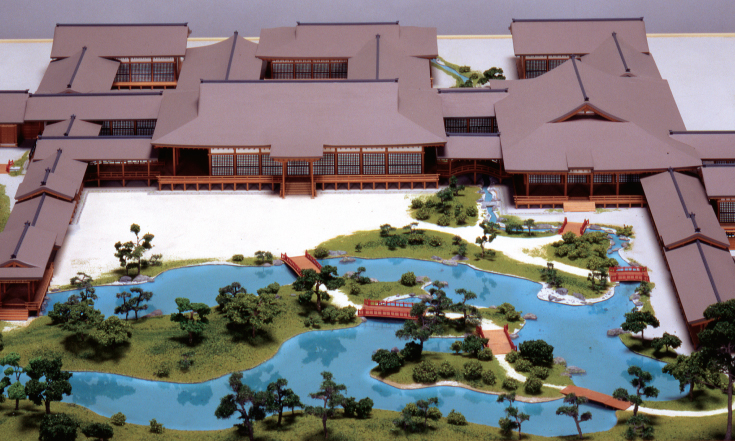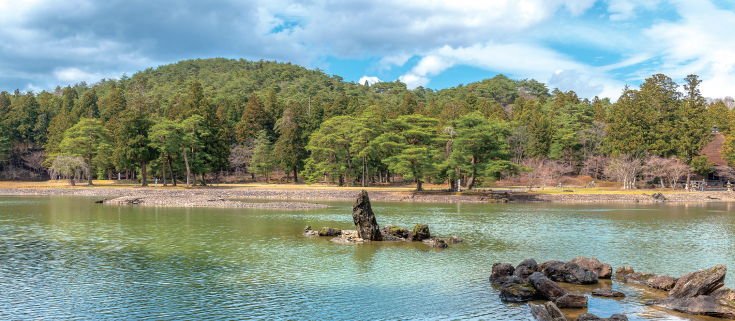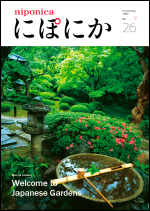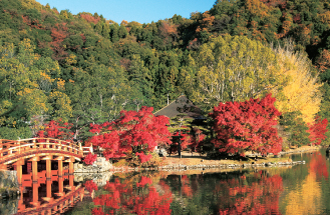niponica is a web magazine that introduces modern Japan to people all over the world.
2019 NO.26
Welcome to Japanese Gardens

Japanese Gardens –Changes in Style
Japanese gardens are characterized by modeling after natural scenery. How has the style been established and changed? Let’s trace the history of Japanese gardens that have been affected by each era and have developed in a unique way.
Supervised by: Amasaki Hiromasa
Characteristics of Japanese Gardens
The Japanese garden expresses artificial hills, ponds, and streams through artistic use of trees, rocks, sand, etc. In contrast to the geometrically arranged trees and rocks of a Western-style garden, Japanese garden design traditionally minimizes human involvement as far as possible to create a scenic composition that, mimics nature.
7th century – 8th century
Gardens in Ancient Times

East Palace Garden on the Nara Palace Site (Nara Prefecture) with an extensive suhama on the shore of the pond, in front of the building; restored from about 1,300 years ago.
The earliest known gardens in Japan date back to the Asuka period (593–710) and the Nara period (710–794). In the Yamato area (former Nara Prefecture), imperial family and powerful clans created ocean scenes that featured large ponds dotted with islands and suhama (sandy beaches) on the shore.
9th century
Gardens of the Shinden-zukuri Style

Model of Higashi Sanjoden in Heiankyo (ancient Kyoto). At present, there is no existing shinden-zukuri style garden that retains the original state. Starting from the courtyard in front of the main hall, a series of bridges linking the islands enable visitors to stroll across the pond.
The capital of Japan was moved from Nara to Kyoto in 794, and the Heian period (794–1185) began. As a noble family, the Fujiwara clan, consolidated its grip on power, art and culture based on unique Japanese ideas developed. These aristocrats lived in luxurious mansions built in the style called shinden-zukuri. The gardens of that era were also magnificent.
Several rivers converged on Kyoto, which was also richly endowed with spring water. Because summertime conditions in Kyoto are hot and humid, local residents fashioned ponds and waterfalls in order to evoke a sense of coolness. Streams called yarimizu were made to flow between buildings and through the gardens of mansions. In the mansion grounds, they created ponds large enough to accommodate boating and also fishing pavilions that projected over the water and were connected by covered corridors to the other structures. These pavilions were ideal for enjoying the cool of the evening or watching the moon or snow. Between the main buildings and the pond was an area covered with white sand, providing a picturesque site for the holding of formal ceremonies.
10th century – 11th century
Jodo Gardens

Motsuji Temple Garden (Iwate Prefecture), a good example of a jodo garden
From the 10th through 11th centuries, Japan’s aristocracy became increasingly devout in its practice of Buddhism. As the belief spread that the true teaching of Buddhism might disappear in due course, the gardens came to be modeled on images of jodo (pure land) as described in scripture and religious tracts. In this type of garden, the focal point is the pond, with an arched bridge reaching to a central island. Motsuji Temple in Iwate Prefecture and Shiramizu Amidado in Fukushima Prefecture still demonstrate the atmosphere of Jodo gardens.





